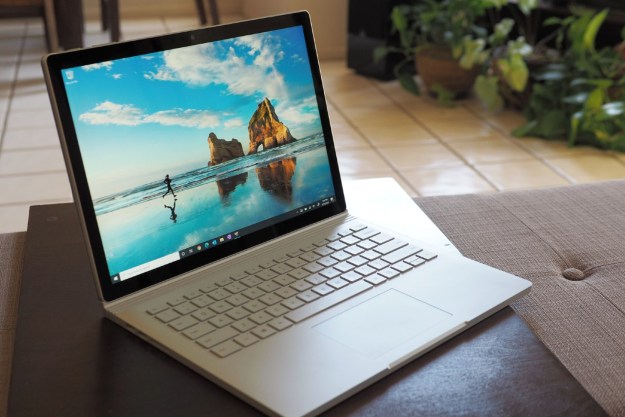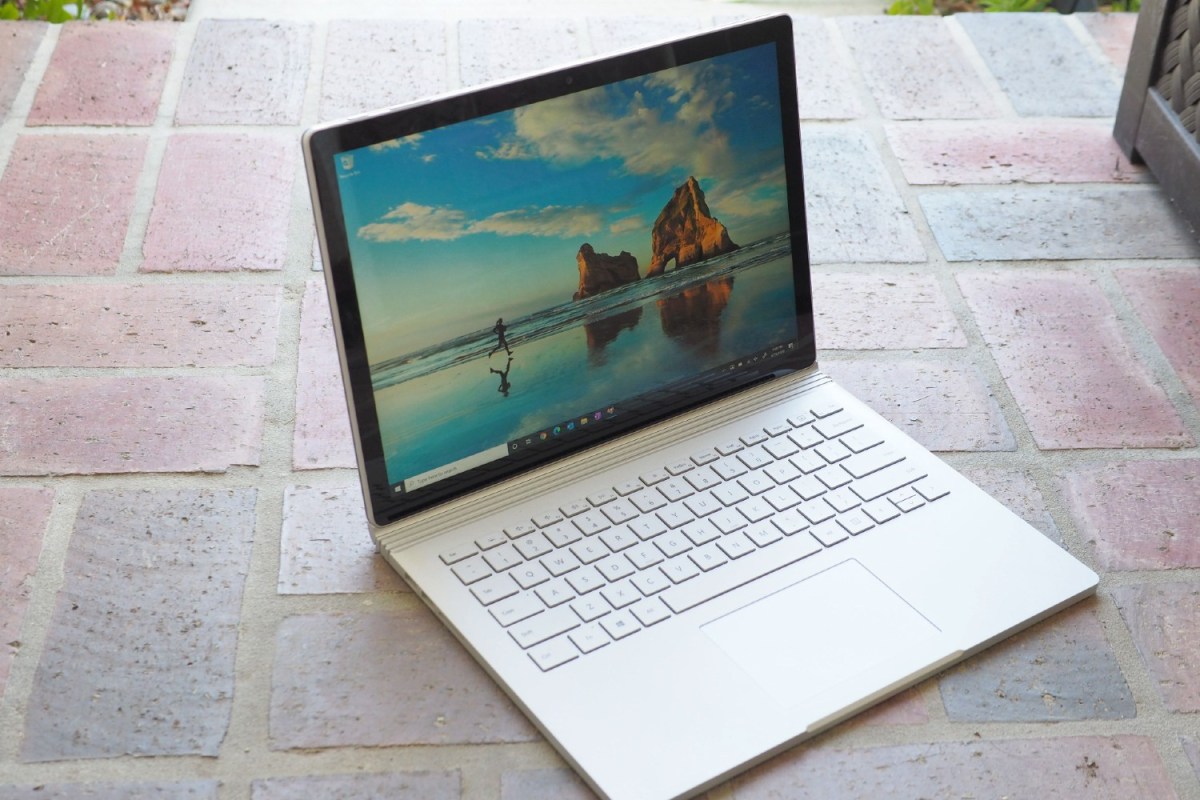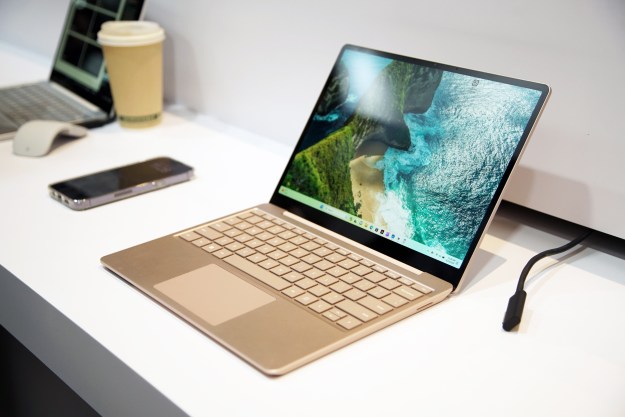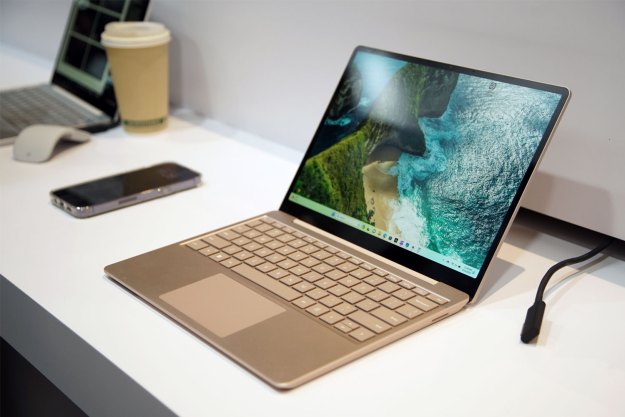
- Strong performance
- Good battery life
- Excellent input options
- Sharp, high-contrast display
- Bulky chassis
- Expensive
The Surface Book 3 claims to be Microsoft’s performance-driven laptop. That can sometimes pose a problem for the 15-inch model, which has to compete against some of the best laptops like the Dell XPS 15 and Apple MacBook Pro 16-inch. Those laptops use powerful eight-core Intel Core i9 processors, which promise excellent performance.
But a powerful 13-inch laptop is more rare. That’s where this smaller Surface Book 3 has a chance to shine. My review configuration came with an Intel 10th-gen Core i7 CPU, a discrete Nvidia GTX 1650 Max-Q graphics card, and a whopping 32GB of RAM.
The $2,500 price is high, no doubt, but based on the specs alone, this might be the most powerful 13-inch laptop ever made.
Design

The Surface Book 3 is a bit of a contradiction. On the one hand, it remains the most futuristic laptop on the market today, despite a design that’s identical to the Surface Book 2 released in late 2017. Pushing a button and tearing off the display is just as satisfyingly geeky as always — no other 2-in-1 is quite so cool.
And the build quality is excellent, rivaling the MacBook line for sheer elegance and solidity. There’s not a creak, bend, or groan from the laptop, no matter how you handle it, in the lid, the keyboard deck, or the chassis bottom. The Surface line, in general, is well made, and the Surface Book 3 offers perhaps the most impressive build quality of them all.
At the same time, the Surface Book 3 feels a bit ancient. Its display bezels are relatively huge, and the same can be said about the bulky chassis. While other laptops are squeezing into tiny frames thanks to minuscule bezels, the Surface Book 3 feels like a throwback to when machines were thick and chunky.
You won’t find it easy to use on an airliner’s tray table.
As a 13-inch class laptop, it competes with the incredibly svelte HP Spectre x360 13 and the Dell XPS 13, both of which are noticeably smaller (more than 1.5 inches less deep, for example). The Surface Book 3 is 0.59 inches thick at its thinnest point in front, which seems thin enough, but then it flares to a massive 0.91 inches in back due to the rounded fulcrum hinge. The Spectre x360 13 is 0.67 inches, and the XPS 13 is 0.58 inches, and they both feel quite a bit thinner. The Surface Book 3 also weighs 3.62 pounds compared to the HP at 2.88 pounds and the Dell at 2.65 pounds.
You won’t find it easy to use the Surface Book 3 on an airliner’s tray table, for example, especially given how the display is set further back than those on most other models; like the thickness, this is due to the fulcrum hinge that’s designed to balance the heavier-than-usual display. You can flip the display around and use it in media mode easily enough, but then again, the same can be said for other 2-in-1s. And smaller laptops like the Spectre x360 13 and the XPS 13 fit just fine in the same kind of limited spaces.
One advantage of the Surface Book 3’s design is that unless you’re pushing the discrete GPU, the keyboard base remains cools thanks to the heat-producing components being in the display.

As a tablet, though, the Surface Book 3 is very comfortable, with only one major drawback. To begin with, it’s thin and light, surprisingly so for its 13.5-inch size. And it’s great for inking thanks to the 3:2 aspect ratio that’s closer in dimensions to a sheet of paper and great support for Microsoft’s active Surface Pen. It might be an older design, but it remains quite functional.
The only problem with using the Surface Book 3 as a tablet is that unlike the Surface Pro 7, for example, there’s no kickstand and so no easy way to prop it up for, say, watching media. The best way to binge Netflix, then, is to flip the tablet around on the fulcrum hinge and use the keyboard base to prop things up. It’s not as lightweight a solution, but it works well.
Connectivity is another area where Microsoft hasn’t fully embraced modern computing. The Surface Book 3 has two USB-A 3.1 ports, an SD card reader, a USB-C 3.1 port, and the Microsoft Surface Connect port that provides the fastest charging, as well as connectivity to the company’s new Surface Dock 2. Those ports are all on the keyboard dock, while the tablet has a Surface Connect port for charging.
Thunderbolt 3 is missing, which limits the number and performance of attached devices. It also means the Surface Book 3 can’t connect to external GPUs. According to internal reports, Thunderbolt 3 represents a security risk, and that’s the reason it’s been left it off of Surface devices.
Performance

So, yes, the Surface Book 3 is large for a 13-inch laptop. But there’s a reason: The display houses most of the computer’s components, including the CPU and most of the electronics. The keyboard base houses the discrete GPU (on the Core i7 models) and a bunch of battery capacity. That’s why the laptop is so thick overall and why the tablet section is so relatively bulky compared to a simple display.
In my testing, the Surface Book 3 was plenty fast in my review configuration with a 10th-gen Intel Core i7-1065G7 and 32GB of RAM (unusual for 13-inch laptops). It churned through our benchmarks, scoring better than many of its 13-inch competitors. In Geekbench 5, for example, it beat out the HP Spectre x360 13 and matched the Dell XPS 13. It was even faster than our review configuration of the Surface Book 3 15, which had less memory.
The Surface Book 3 is a performance leader among 13-inch laptops.
In our real-world Handbrake test that encoded a 420MB video as H.265, the Surface Book 3 finished in a second over 3 minutes, again almost exactly matching the very quick Dell XPS 13 and beating the Spectre x360 13 by almost a minute.
That makes the Surface Book 3 a performance leader among 13-inch laptops. The MacBook Pro is the only 13-inch laptop to surpass it in CPU performance, thanks to its custom 25-watt processor.
Toss in the Nvidia GeForce GTX 1650 Max-Q graphics, and you have a laptop that’s going to be even more competitive for any creative application that can make use of the GPU. This isn’t the fastest GPU around, but it’s much faster than the Intel integrated graphics that nearly every 13-inch laptop relies upon. The only other outlier is the Razer Blade Stealth 13, which uses the GTX 1650 Ti. That laptop doesn’t have the unique design of the Surface Book, which doesn’t force the GPU and CPU to share the same space.
Gaming

Chances are, you’ll want to run the GTX 1650 Max-Q through its paces and use the Surface Book 3 13 as an entry-level gaming laptop. And for the most part, you can do that — as long as you temper your expectations. I ran the laptop through our gaming tests and came away a little underwhelmed. The laptop isn’t quite as fast as some other laptops with similar GPUs, though most of those are larger 15-inch laptops.
For example, the Surface Book 3 was well behind the earlier Dell XPS 15 with the GTX 1650, and even further behind the newest XPS 15 with the GTX 1650 Ti, in all of our benchmarks. That includes the synthetic 3DMark suite, where the older XPS 15 was more than 10% faster, and the newer model was almost 20% faster. Civilization VI was one game where the Surface Book 3 was a little more competitive, likely thanks to the strong CPU performance, where it managed 68 frames per second (FPS) in 1080p and medium graphics compared to the older XPS 15 at 56 FPS and the newer model at 114 FPS. In Assassin’s Creed: Odyssey, though, the Surface Book 3 only managed 25 FPS in 1080p and high settings, compared to the older XPS 15 at 42 FPS and the newer model at 47 FPS. The trend held up in Battlefield V, with the Surface Book 3 hit 41 FPS compared to 54 FPS for the older XPS and 60 FPS for the newer model.
The Surface Book 3 couldn’t hit 60 FPS in Fortnite, a more lightweight game that serves as a benchmark for entry-level gaming. The older XPS 15 managed 67 FPS and the newer model hit 74 FPS. Overall, if you turn down graphical details, you can get playable frame rates at 1080p out of the Surface Book 3, and that’s excellent for a 13-inch class laptop. Just don’t expect it to replace a bona fide gaming laptop any time soon.
Of course, the discrete graphics don’t come standard. The base model starts at $1,600, and you’ll need pay $500 more to get that extra graphics performance. The larger 15-inch version comes with the option for the more powerful GTX 1660 Ti.
Display

The Surface Book 3 has an IPS display in the productivity-friendly 3:2 aspect ratio and a high 3,000 x 2,000 resolution. It’s not quite 4K, but both text and image details are sharp as a tack. As with all of the Surface devices, all configurations of the Surface Book 3 include this same high-resolution display.
According to my colorimeter, the display has its positives and negatives. To begin with, it’s bright at 422 nits and has excellent contrast of 1,420:1 (we like displays that are 1000:1 or higher). That’s the good stuff. The color gamut isn’t terribly wide, though, at 94% sRGB and 73% AdobeRGB, and they’re not the most accurate at 2.10 (1.0 or less is considered excellent). You can get better displays on 13-inch laptops, such as the OLED display on the HP Spectre x360 13 and the excellent 4K display on the Dell XPS 13 — both of which offer wider and more accurate colors and equivalent or better brightness and contrast.
The Surface Book 3’s display is a real pleasure to use. You get more vertical space thanks to the aspect ratio, for what feels like a more expansive workspace. Although that results in some letterboxing when watching video, the images are sharp and bright.
Audio isn’t as impressive, though. There are two forward-facing speakers on the display portion, and they put out enough volume for watching the occasional YouTube video. But bass is lacking, and you’ll want to keep a pair of headphones handy if high-quality sound matters to you.
Battery life

One of the Surface Book 2’s claims to fame was its battery life, as it was among the longest-lasting 13-inch laptops around. The Surface Book 3 takes a step back, offering up strong but not quite class-leading longevity — this is another area where the competition has caught up and surpassed Microsoft’s offering.
The Surface Book 3 lasted 5 hours in our demanding Basemark web benchmark test, which is a good result and beats out the 15-inch Surface Book 3 and the Dell XPS 13 with a Full HD display. In our web-browsing test, the Surface Book 3 managed just under 10 hours, a good but not great score that the XPS 13 beat by 100 minutes. And in our video looping test, the Surface Book 3 went for just over 13.5 hours, which was almost an hour less than the XPS 13. Of course, that’s not a completely fair test given the XPS 13’s Full HD display. Compared to the HP Spectre x360 13 with its OLED display, the Surface Book 3 lasted for hours longer in web browsing and video watching. Note that the Surface Book 2 lasted 20.6 hours looping our test video and 15.5 hours browsing the web.
Most of the battery capacity is in the keyboard base, though, and so popping off the display and using it as a tablet severely limits battery life. In this mode, the Surface Book 3 lasted just under 1.5 hours on the Basemark test, less than 2.5 hours on the web browsing test, and just 3.5 hours playing our test video. That’s disappointing, particularly compared to other tablets that last for hours longer, like the Surface Pro 7.
Keyboard and touchpad

The Surface Book 3 has always had one of the best keyboards around. It has plenty of travel with a snappy feel that makes for a precise and comfortable typing experience. It’s also rather quiet, which is a plus in terms of working without disturbing anyone around you. I like the Magic Keyboard on the latest MacBooks better, but the Surface Book 3 comes close to tying my second-favorite, the keyboard on the Spectre x360 13.
The touchpad works well, too. It’s built with Microsoft Precision Touchpad drivers and offers up a smooth and consistent Windows 10 multitouch experience. It’s as good a touchpad as you’ll find on a Windows laptop, even though it’s smaller than it could be given the available space on the keyboard deck. The size didn’t hold me back, though.
The display is touch-enabled, of course, and it’s as responsive as all Surface displays. It supports Microsoft’s excellent Surface Pen, which offers tilt, 4,096 levels of pressure sensitivity, and one of the best Windows inking experiences around. As mentioned earlier, the display is in the 3:2 aspect ratio that makes it seem a lot more like a normal 8.5 x 11 sheet of paper. It’s just unfortunate that the $100 Surface Pen isn’t included with such an expensive laptop.
Finally, the Surface Book 3 supports Windows 10 Hello password-free login via an infrared camera and facial recognition. It’s fast and reliable, and it’s better than a fingerprint reader on the keyboard deck because it works in tablet-only mode.
Our take
The Microsoft Surface Book 3 is a unique 13-inch laptop. It’s larger than its competition by a fair margin, but it makes up for that with strong performance that you’ll find in few other similarly sized machines. Compared to the Surface Book 2, the latest model is simply a faster iteration of a tried-and-true design.
It’s also very expensive, with my review configuration coming in at $2,500. Its unique design makes it hard to compare to other laptops, but it’s only worth the cost if you’re convinced about the usefulness of the tablet elements as well.
Are there any alternatives?
You could choose from among the other Surface devices if you’re simply enamored with the brand. The Surface Pro 7 and Surface Pro X will give you better tablet experiences, and the Surface Laptop 3 is a more traditional clamshell offering. None of them, though, offer the same level of performance.
The only other 13-inch laptop to offer a similar level graphics performance is the Razer Blade Stealth. The Stealth is a bit cheaper, and you can get the GTX 1650 Ti model with options for either a 144Hz refresh rate display or a 4K touchscreen.
How long will it last?
The Surface Book 3 is built like a tank and uses up-to-date components (other than the lack of Thunderbolt 3). It will give you years of productive service. You’ll also enjoy the 60-day return policy and year of in-store technical support if you buy from a local Microsoft Store, which is a real plus. The 1-year warranty, though, is standard and less impressive.
Should you buy it?
Yes. It’s 2-in-1 design and powerful graphics make it a one-of-a-kind laptop.
Hoping for a discount on the Surface or other laptops? Check out the best Microsoft Surface Pro deals and the best laptop deals we’ve found online.
Editors' Recommendations
- Dell XPS vs. Dell Latitude: here’s how to decide
- The best 2-in-1 gaming laptops for 2024
- The best laptops for music production, chosen by experts
- This sleeper Asus laptop is faster and cheaper than Microsoft’s Surface Laptop Go 3
- Surface Laptop Go 3 vs. Surface Pro 7+: is it an upgrade?



